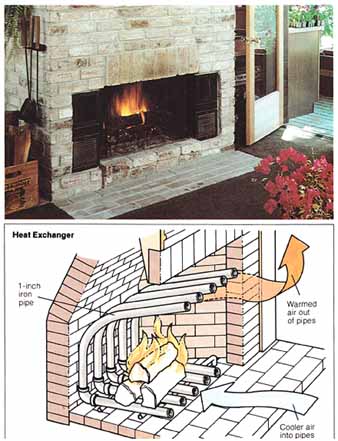Another way to gain heat from your fireplace is to buy or build a heat ex changer. Not to be confused with the heat exchanger inside a furnace or a solar water heater, this instrument is essentially a grate to hold your burning logs in a position that forces the heated air back out to you.
To build a heat exchanger, use lengths of 1-inch iron pipe, curved to rise from a position flush with the floor of your firebox until they point out into the room. The exact length of these pieces of pipe, as well as the number you will need, depends on the size of your fireplace and on the size of the logs you burn in it; however, they should be spaced at about 4-inch intervals. The top ends of the pipes should extend a bit beyond the fireplace. Attach the curved pipes at the bottom to straight sections of the same kind of pipe, using ordinary pipe elbows. Weld the straight pieces of pipe to a plain iron fireplace grate, or to a few more pieces of pipe, bent to form legs. When a fire blazes in the heat-exchanger grate, cold air gets sucked into the open pipes at the bottom, where it’s warmed by the fire and then forced out the top grate openings and into the room. In principle, this is a tiny chimney-effect. If you are venting cold air from the outside into your fireplace at the same time, this process will work even more effectively
—the fire will get most of its oxygen from that air instead of from the air in your house that’s already been heated. This device works best with fan-forced air. But with or without a fan, it will pump a certain amount of soot into your room, along with the heat.

Drawing on cool air from outside, or from the bottom of the room along
the floor, a heat circulating fireplace returns warmed air out into the
room through its ducts.
(bottom) Heat Exchanger: A heat exchanger is one way to increase the efficiency of nearly any fireplace, since it is specially constructed to return air to the room after it has been warmed. Tools include a 1-inch iron pipe.
Next: Wood-Burning Stoves
Prev: Fireplaces